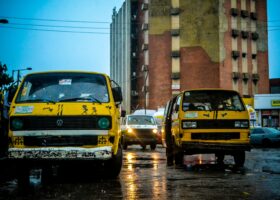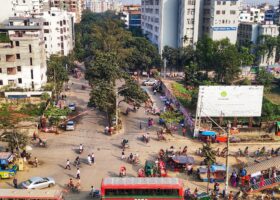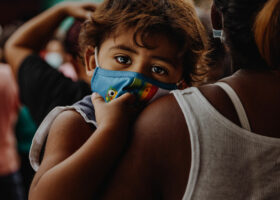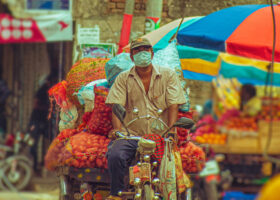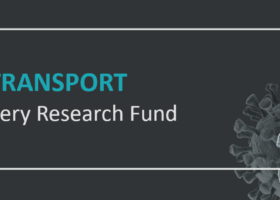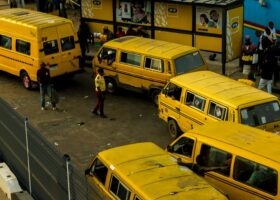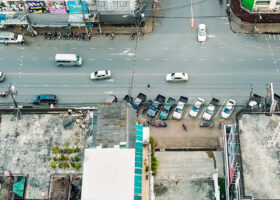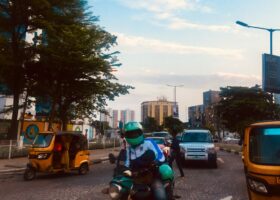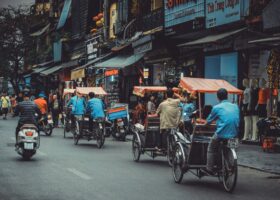Overview
Did COVID19 related policies affect the spread of the pandemic?
Yes they did. Regression analysis of daily new positive COVID-19 cases in Bangladesh (Fig. 2) reveals that many of the interventions had the desired effects in terms of reducing the spread of the pandemic. Although some of the restrictions were combined together at the beginning, the main interest is on the relative impacts of individual measures, which is presented here. The largest beneìcial impact was derived from the full closure of oêces and public transport. Since these two happened at the same time, their effects could not be estimated separately. The closure of shops at the beginning also had beneìcial effects, but the effect was around 70% of the joint effects of full ‘oêce and public transport’ closure. This high impact was due to the heavy shopping prior to the Eid-ul-Fitr, when the restriction was lifted. Statistically, the operation of public transport system and oêces at half capacity did not have any impact on the spread – this is possibly a result of lax implementation. Opening of garment factories earlier than other oêces did not have a statistically signiìcant adverse effect, but the large mobilization of people during the indecision of opening garment factories by the business leaders did. Somewhat surprisingl surprisingly, the mandatory mask use regulation did not have any statistically signiìcant effect. This is possibly because of the lax and inappropriate use of masks, and the risk-compensation due to increased mobility and interactions resulting from a sense of safety due to the mask regulation. Stricter implementations and effective messaging would likely have a signiìcant impact. Eid-ul-Fitr increased the spread, likely due to the increased social interactions during the festivities. We did not get statistically signiìcant effects for Eid-ul-Adha, possibly because mobility was already increasing due to the compulsory mask mandate. Fig. 3 on the relative effectiveness of different policies can be used for future intervention design, with the caveat that the results are dependent on the quality of the underlying data.
Publications with the same themes
Publications with the same study countries
Related news & events
News
Blog
News
News
News
Blog
News
Blog
PDF content (text-only)
Links between Transport, Air Quality and COVID-19 Spread in Bangladesh Summary of Findings Bangladesh University of Engineering and Technology Did COVID19 related policies affect the spread of the pandemic? What is the policy timeline? Yes they did. Regression analysis of daily new positive COVID-19 cases in Bangladesh (Fig. 2) reveals that many of the interventions had the desired effects in terms of reducing the spread of the pandemic. Although some of the restrictions were combined together at the beginning, the main interest is on the relative impacts of individual measures, which is presented here. The largest beneìcial impact was derived from the full closure of oêces and public transport. Since these two happened at the same time, their effects could not be estimated separately. The closure of shops at the beginning also had beneìcial effects, but the effect was around 70% of the joint effects of full ‘oêce and public transport’ closure. This high impact was due to the heavy shopping prior to the Eid-ul-Fitr, when the restriction was lifted. Statistically, the operation of public transport system and oêces at half capacity did not have any impact on the spread – this is possibly a result of lax implementation. Opening of garment factories earlier than other oêces did not have a statistically signiìcant adverse effect, but the large mobilization of people during the indecision of opening garment factories by the business leaders did. Somewhat surprisingl surprisingly, the mandatory mask use regulation did not have any statistically signiìcant effect. This is possibly because of the lax and inappropriate use of masks, and the risk-compensation due to increased mobility and interactions resulting from a sense of safety due to the mask regulation. Stricter implementations and effective messaging would likely have a signiìcant impact. Eid-ul-Fitr increased the spread, likely due to the increased social interactions during the festivities. We did not get statistically signiìcant effects for Eid-ul-Adha, possibly because mobility was already increasing due to the compulsory mask mandate. Fig. 3 on the relative effectiveness of different policies can be used for future intervention design, with the caveat that the results are dependent on the quality of the underlying data. 01 Oêce half capacity Shopping closed Mandatory mask Garments closed Garments dilemma PT half capacity Eid ul Adha Eid ul Fitr 80 60 40 20 -20 -40 -60 -80 0 Oêce + PT closed Fig 1 : Timeline of government interventions and events affecting the spread of COVID-19 ìrst wave in Bangladesh Fig 2 : Daily new COVID-19 cases in Bangladesh during the ìrst wave Fig 3 : Relative effects of different policies and events on increase or decrease in daily new cases 15 Mar 15 Apr 15 May 15 Jun 15 Jul 15 Aug 15 Sep 15 Oct 15 Nov 0 1000 2000 3000 4000 5000 Did COVID-19 related policies affect mobility? Did COVID-19 related policies reduce accidents? Indeed they did. Daily activities and – as such mobility – at different types of locations in Bangladesh reduced dramatically during the COVID-19 related interventions and disruptions (Fig. 4). After an initial rapid reduction, mobility started to recover gradually, and returned to near-normal just before September 2020. Regression analysis shows that most of the policy measures affected mobility in the expected direction, with some differences in the effectiveness in different locations. Closure of education institutes, oêces, public transport and retail and recreation venues have all reduced mobility at most locations. The closure of garment factories reduced mobility for work and at transit stations only. Oêce opening at half capacity had a signiìcant effect on oêce travel, but not at other locations. As mobility at other locations fell, home stays have increased substantially. Mandatory use of masks increased mobility at all places (except in residences), suggesting risk compensation and likely explains why this important policy may not have showed a statistically signiìcant reduction in daily new cases (see previous section). The relative contribution of different policy measures on mobility at different locations, can be used to devise future policies (Fig. 5). It depends. Accidents and fatalities may appear to have fallen in Bangladesh during a 5-month travel disruption period (April – August 2020) compared to a 19-month normal period (January 2019 – December 2020, barring the disruption), however, statistically accidents and fatalities in Bangladesh did not fall. This is because of the large variability in the monthly accident data. More importantly, once the effects of the reduction in mobility are considered, normalized accidents and fatalities increased in Bangladesh in a statistically signiìcant manner during the travel disruptions. Increases in speed resulting from reduced traêc on the road is the likely cause of this increase. However, tr in Dhaka normalized accidents and fatalities fell and roads became safer during the disruptions. This was likely driven by a lower number of pedestrians and vulnerable road users in Dhaka during the disruption period and stricter implementation of the policies. This result suggests – a) road safety impacts are location speciìc; b) there should be adequate policy attention on road safety even during the reduced mobility periods, especially outside of Dhaka; c) safer travel option for vulnerable road users has a large role in improving road safety; and d) not controlling for reduced mobility shall provide misleading picture during data analysis. c 02 -20 20 20 0 -20 -40 -60 -80 15 Feb 15 Mar 15 Apr 15 May 15 Jun 15 Jul15 Aug15 Sep 15 Oct15 Nov 0 -40 -60 -80 -100 Fig. 4 : Activity index at different locations, relative to a pre-COVID-19 baseline Fig. 6 : Monthly number of accidents and fatalities in Bangladesh and Dhaka Bangladesh Dhaka 40 20 0 Normal period COVID19 disruption 160 140 120 100 80 60 0 20 40 60 80 100 120 140 160 Normalized Accidents Monthly Accidents Normalized Fatalities Monthly Fatalities Fig. 5 : Relative effects of policies and events on the increase or decrease in activities at various locations Retail and recreation Workplaces Retail and recreation Retail and recreation Workplaces Workplaces Statistically Signiìcant Effect Statistically Not Signiìcant Effect Educational institution closed Shopping mall closed Garments closed Oêce+ PT closed Oêce half capacity PT half capacity Mandatory mask Did COVID-19 related policies improve air quality? Data & Methods It depends. Statistically, air quality improved at Farmgate, Dhaka – this is likely due to the large contribution of construction pollution at that location. Regression results show that at Baridhara in Dhaka air quality improved immediately in the ìrst month, but over the ìve months of traêc disruptions, it did not. Air quality did not improve at Darussalam Road in Dhaka either in the ìrst month or longer ìve months of traêc disruptions. All of these results control for the differences in weather elements over the year, which has crucial role in understanding the impacts. Results indicate – a) air quality impacts and associated health beneìts a beneìts are location speciìc – even within the same city and for the same policy, impacts vary; b) traêc may not be as large a source of air pollution in Dhaka now (as massive reductions in traêc did not improve air quality as much); and c) not controlling for weather shall result in misleading conclusions. The analysis is based on data on the number of daily new infections in Bangladesh from www.corona.gov.bd and Johns Hopkins University, daily mobility/activity data from Google Community Mobility Report, monthly accident data from Bangladesh Police and Accident Research Institute at BUET, hourly air quality data (converted to daily) from the Department of Environment and hourly weather data (converted to daily) from National Oceanic and Atmospheric Administration and Bangladesh Meteorological Department. Dynamic time series regression models with indicator variables for interventions and events were applied to understand the impacts of different policies and events for all research questions, except accidents and fatalities, which used simpler descriptive statistics. It is important to note that with aggregated timeseries data, as used here, some of the nuances may not be extracted statistically, and further research and evidence gathering are necessary for understanding the ìner details. 03 PM 2.5 concentration (μg/m³) PM 2.5 concentration (μg/m³) BARC US Embassy Darussalam PM 2.5 concentration (μg/m³) 0 50 100 150 200 Jan Feb Mar Apr May Jun Jul Aug Sep Oct Nov 0 50 100 150 200 Jan Feb Mar Apr May Jun Jul Aug Sep Oct Nov 0 50 100 150 200 Jan Feb Mar Apr May Jun Jul Aug Sep Oct Nov Fig 7 : Monthly average of daily PM2.5 concentration at different locations in Dhaka Monthly average of 2015 to 2019 Monthly total rainfall (average of 2015 -2019) Monthly average of 2020 Monthly total rainfall in 2020 *For US Embassy. the timeline of the graph is 2016-2019 This research was funded by UKAid through the UK Foreign, Commonwealth & Development Oêce under the High Volume Transport Applied Research Programme, managed by IMC Worldwide. The views expressed in this brieìng are authors’ own and do not necessarily reíect the views of the governments of the UK or Bangladesh. The detailed ìnal report will be available at https://transport-links.com/welcome-to-our-research-hub/ in June 2021. Investigators: Reviewers: Dr. Md. Shamsul Hoque, Dr. Suman Ahmed, Tali Trigg Graphic Design: Tarif Tasnim Araf (tarifaraf10@gmail.com) Dr. Sheikh Mokhlesur Rahman (smrahman@ce.buet.ac.bd), Bangladesh University of Engineering and Technology Dr. Annesha Enam (annesha@ce.buet.ac.bd), Bangladesh University of Engineering and Technology Dr. SM Sohel Mahmud (smsohelmahmud@gmail.com), Bangladesh University of Engineering and Technology Dr. Zia Wadud (Z.Wadud@leeds.ac.uk), University of Leeds, Principal Investigator About the Project


